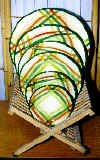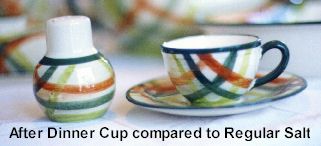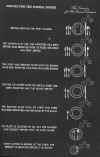 "Ever wonder
how to properly use dinnerware in the formal table setting?"
"Ever wonder
how to properly use dinnerware in the formal table setting?"
The greatest medium for bringing color and warmth to a formal table setting is the china. The stately dignity that a formal occasion demands can be mirrored in the dinnerware and in the delicate patterns of the luncheon china. The homemaker can accent the period setting of her room by selecting a china appropriate to that period or she can select different patterns and colors for the various courses, all of which blend harmoniously. Cups, saucers and little plates for tea service may be patterned or a solid white or ivory, and used with service plates of china.
Plates and How They are Used
Dinnerware producers have not agreed on measurement and standardization of plate sizes, giving rise to much confusion. The various trade sizes are often used to designate the same size plate, so, in the following list, measurements, in inches are from rim to rim.
Service plate (also called a cover plate, place plate, or lay plate): 10
to 11 inches, placed at each cover.
Dinner plate (roast plate): 10 inches, but seen as large as 10 ˝ inches.
Entree plate: 8 ˝ to 9 ˝ inches. Used for serving salad, fish, the entree, and the dessert when the finger bowl is brought in with the dessert silver.
Dessert plate: 7 ˝ to 8 inches. Used for desserts, salads, and as the cake plate at teas.
Bread-and-butter plate: 6 to 6 ˝ inches. Used for all occasions except formal dinners. May be used for tea service to hold sandwiches, muffins, cakes and cups of tea.
Soup plate: 8 to 8 ˝ inches at rim, for the usual type of soup plate with the wide, flat rim. There is also a bowl soup plate, or coup soup, which has no rim.
 Cream soup cup:
4 ˝ to 5 inches wide and about 2 inches deep. This low, broad cup, handled on both sides,
is used for serving purees, bisques, cream soups, and clear soup at lunches and informal
dinners.
Cream soup cup:
4 ˝ to 5 inches wide and about 2 inches deep. This low, broad cup, handled on both sides,
is used for serving purees, bisques, cream soups, and clear soup at lunches and informal
dinners.
Bouillon cup: this is the size of a tea cup but has 2 handles. Clear soups, consommés and bouillons are served in it.
 After-dinner coffee cup and saucer: these tiny cups and saucers are
used for after-dinner coffee or demitasse. They come in sets, or a collection of various
shapes and sizes may be used: thus they need not match.
After-dinner coffee cup and saucer: these tiny cups and saucers are
used for after-dinner coffee or demitasse. They come in sets, or a collection of various
shapes and sizes may be used: thus they need not match.
 GLASS
GLASS
"Clear, sparkling glass is the resplendent note on the formal table. The king of the table glass, the long-stemmed goblet, is the preferred water glass for formal dinner use and is accompanied by not more than 3 other glasses, a glass for sherry, a glass for red or white wine and one for champagne. At banquet dinners, 4 glasses, in addition to the goblet, may be used."
The long-stemmed or short-stemmed goblet is correct to use for the formal lunch, and footed or plain tumblers and short-stemmed goblets are used for buffets or formal breakfasts,
For punch service use a large silver, china, or glass bowl, with its accompanying ladle and small cup-like glasses with handles.
Sizes and Use
The shape, size and capacity of each glass differs with its use.
Goblet: capacity, 9 to 10 ounces. Usually from 7 to 8 inches high, the goblet has a flaring round bowl on a tall or short stem. The low goblet stem flares immediately into the foot and both types are used only for water. The goblet always has a foot, no matter how short the stem. It is the dominant member of the place-glass group and sets the style.
Large wineglass: capacity, 4 to 6 ounces. A duplicate of the goblet, the large wineglass used for dinner wines is the other regular member of the place glass group. The all-around wineglass holds about 5 ounces and is used throughout the entire meal.
Small wineglass: capacity. 2 to 3 ounces. Used for dessert, appetizer and heavier wines, at the table and away from it.
Cocktail glass: capacity, 2ounces. Coming in countless shapes, the cocktail glass need not match the glass table service.
Brandy-inhaler: capacity, 5 ounces. This glass is recognized by its huge bowl in which is twirled 1 ounce of choice brandy for the development and enjoyment of the bouquet. This "snifter" may be 10, 14 or 16 ounces.
Liqueur glass: capacity less than 1 ounce. Used to serve brandies or liqueurs. This glass may resemble tumbler the wineglass or parfait glass, but need not match the other glass.
Claret glass: capacity, 4 ounces. A round, bowl-shaped top on a tall stem and used for red and white wines.
Port glass: capacity, 3 ounces. Claret glass shaped.
Sherry glass: capacity, 4 to 5 ounces. Triangular in shape when viewed sideways and known as the "pipestem" glass.
Rhinewine glass: capacity, 4 to 5 ounces. This glass often has elaborate bowls and does not need to match the other place glass group. Used to serve Rhinewines and Moselles.
Champagne glasses: Glasses for champagne are of many varieties, should be of thin crystal and not over-decorated.
Coup: This is a very shallow bowl on a tall, solid stem flared to a foot and is known as the "saucer" glass.
Trumpet: This is a tall, slender glass, cornucopia shape, very narrow at base, and on a foot. The pointed bottom where it joins the foot aids the release of bubbles.
Hollow: stern-This bowl of glass rests on a tubular stem and foot. The stem, open at the top, allows a rising fountain of bubbles.
Goblet: This is like a small water goblet.
Sherbet glass: capacity, 5 ounces. This glass has a medium depth, broad bowl on either a stem or a low foot and is used to serve ice cream, sherbet and frozen dessert.
Cocktail bowl with liner: This is a double bowl- a large bowl on a stem which holds cracked ice, and a small cup which contains the chilled seafood, grapefruit or other cocktails, It is sometimes called a grapefruit bowl and comes in many sizes.
Finger bowl: The finger bowl is a low, broad bowl, round in shape and sometimes footed. I t may come with matching under-plate, the use of which is optional.
Compote: This is a shallow bowl from 4 to 6 inches in width on a thick stem and foot and is used for candies and nuts.
